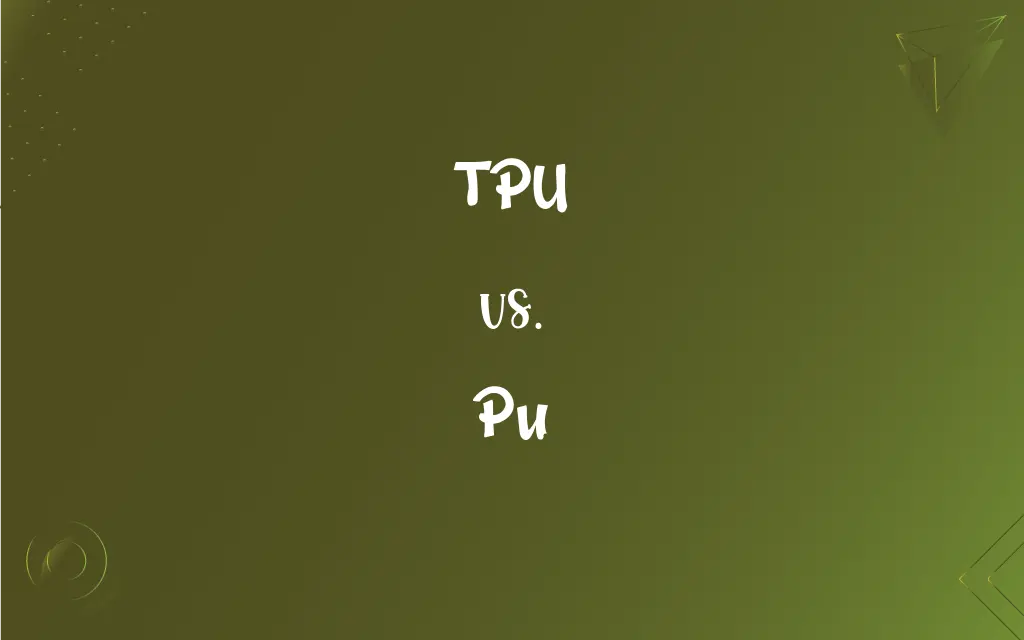TPU vs. PU: What's the Difference?
Edited by Janet White || By Harlon Moss || Updated on October 3, 2023
TPU (Thermoplastic Polyurethane) is a versatile plastic, often used in 3D printing, while PU (Polyurethane) is a polymer used in various forms, including foams and coatings.

Key Differences
TPU, which stands for Thermoplastic Polyurethane, and PU, short for Polyurethane, are both polymers, but they have different characteristics and applications, primarily due to their structural differences. TPU possesses a special quality of flexibility and is utilized in a range of applications including 3D printing filaments, phone cases, and some medical devices. On the other hand, PU is widely recognized and utilized for its rigidity and firmness, finding applications in foams for cushioning and insulation purposes, in addition to being used in paints, and adhesives.
In a more technical context, TPU is renowned for its superior abrasion resistance and ability to function well in high-flexural applications, marking its demand in industries like automotive and consumer electronics. Conversely, PU's flexibility in forms – ranging from hard plastics to soft foams – enables its utility across an extensive spectrum of applications, from automotive seats to insulation materials, and even in the production of some apparel and footwear.
One could observe that TPU typically demonstrates commendable resistance to oils, greases, and a variety of solvents, making it a preferable option in industries that involve constant mechanical movement and exposure to such materials. PU, while it does exhibit some resistance to oils and greases, is prevalently recognized for its capacity to provide stiff foam (like those used in furniture) or be utilized in various forms in construction, adhesives, and more due to its rigid yet slightly flexible nature.
While TPU can endure a degree of physical stress and has good transparency, PU often finds itself being utilized where transparency is not a prerequisite but where a degree of structural robustness is desired. Importantly, these distinctions guide industries in choosing between TPU and PU based on specific needs and application requirements, often revolving around factors like flexibility, resistance to substances, and physical appearance.
Moreover, from a manufacturing standpoint, TPU is often processed using extrusion and injection molding due to its thermoplastic nature, thereby allowing it to be remolded and recycled. PU, in contrast, may be manufactured using various processes like reaction injection molding and is often utilized in one-time applications, given its lesser ability to be remolded or recycled when compared to TPU.
ADVERTISEMENT
Comparison Chart
Full Form
Thermoplastic Polyurethane
Polyurethane
Flexibility
High flexibility and abrasion resistance.
Ranges from rigid to flexible.
Resistance
Resistant to oils and solvents.
Varied resistance based on form and type.
Applications
3D printing, medical devices, etc.
Foams, adhesives, construction materials.
Recyclability
Can be remolded and recycled.
Limited remolding and recycling ability.
ADVERTISEMENT
TPU and PU Definitions
TPU
A thermoplastic variant of polyurethane.
TPU is favored in some industries for its remoldability and resilience.
Pu
A versatile material used in adhesives and coatings.
The PU adhesive bonded the surfaces securely and durably.
TPU
A material recognized for its resistance to oils and abrasions.
The machinery parts made from TPU resisted wear despite constant use.
Pu
Available in flexible and rigid forms for varied applications.
The rigid PU was used to create sturdy insulation panels.
TPU
A polymer used often in 3D printing.
The artist used TPU filament for creating flexible 3D sculptures.
Pu
A polymer found in various forms like foams and solids.
The mattress contains PU foam for enhanced comfort.
TPU
A type of plastic known for its flexibility and durability.
The phone case made of TPU protected the device during the fall.
Pu
Commonly utilized in the production of furniture and insulation.
The PU insulation successfully kept the house warm during winter.
TPU
Used in manufacturing for creating items requiring repeated flexing.
TPU was chosen for the cable sheathing due to its high-flexural nature.
Pu
Known for being employed in both soft furnishings and hard plastics.
The chair used both PU foam for cushioning and hard PU for armrests.
Pu
A solid silvery gray radioactive transuranic element whose atoms can be split when bombarded with neutrons; found in minute quantities in uranium ores but is usually synthesized in nuclear reactors; 13 isotopes are known with the most important being plutonium 239
FAQs
Why might one choose TPU over PU for certain applications?
TPU might be chosen over PU for applications requiring high flexibility, abrasion resistance, or transparency.
Is PU recyclable?
PU is not as easily recyclable as TPU and often has limited reusability.
What does TPU stand for?
TPU stands for Thermoplastic Polyurethane.
Is PU always used in a solid form?
No, PU can be utilized in various forms, including solid, foam, or even liquid (as in some adhesives).
Can TPU resist oils and solvents?
Yes, TPU is known for its resistance to oils, solvents, and abrasions.
Is PU used in the apparel industry?
Yes, PU is used in the apparel industry, often as synthetic leather or in coatings.
Can PU be used in construction?
Yes, PU is often used in construction, particularly in insulation and sealants.
What is a common application of PU in the automotive industry?
In the automotive industry, PU is often used in vehicle interiors, providing cushioning for seats and insulation for doors and windows.
Can both TPU and PU be found in consumer electronics?
Yes, TPU is often found in items like phone cases, while PU might be used in foams or adhesives within various electronic devices.
What type of PU is typically used for cushioning in furniture?
Flexible polyurethane foam (PU foam) is commonly used for cushioning in furniture due to its comfort and support.
Are there any environmental concerns related to TPU production?
TPU production can have environmental impacts, including the use of isocyanates, which needs proper management and disposal to prevent harmful effects.
Can PU be used in creating water-resistant coatings?
Yes, PU is often utilized to create water-resistant or waterproof coatings in products like waterproof clothing and sealants.
Are TPU and PU safe for use in medical applications?
Both TPU and PU are used in medical applications, but materials used must meet specific biocompatibility and safety standards for medical use.
What are common uses of PU?
PU is commonly used in foams for furniture and insulation, as well as in coatings and adhesives.
Can TPU be used in 3D printing?
Yes, TPU is often used as a filament material in 3D printing due to its flexibility and durability.
How is TPU processed in manufacturing?
TPU can be processed using various methods including injection molding and extrusion, and it is known for its ease of processing in manufacturing.
Are TPU and PU resistant to UV radiation?
While both TPU and PU have some level of UV resistance, specific formulations and additives can enhance their UV stability for outdoor applications.
How does the cost of TPU compare to PU?
Generally, TPU tends to be more expensive than PU due to its additional properties like high flexibility and abrasion resistance, though costs can vary based on specific types and grades.
In what industries is TPU commonly found?
TPU is commonly found in the automotive, medical, and consumer electronics industries, among others.
Is TPU used in the footwear industry?
Yes, TPU is widely used in the footwear industry to create flexible and durable components such as soles and insoles.
About Author
Written by
Harlon MossHarlon is a seasoned quality moderator and accomplished content writer for Difference Wiki. An alumnus of the prestigious University of California, he earned his degree in Computer Science. Leveraging his academic background, Harlon brings a meticulous and informed perspective to his work, ensuring content accuracy and excellence.
Edited by
Janet WhiteJanet White has been an esteemed writer and blogger for Difference Wiki. Holding a Master's degree in Science and Medical Journalism from the prestigious Boston University, she has consistently demonstrated her expertise and passion for her field. When she's not immersed in her work, Janet relishes her time exercising, delving into a good book, and cherishing moments with friends and family.































































